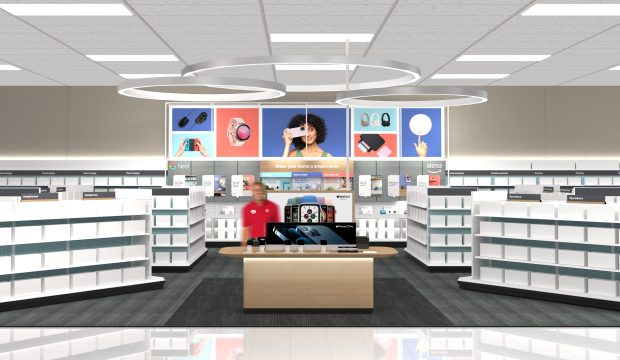Smaller Shops Catching on as Retailers Hone Physical Shopping Experience

Retailers, many known for their expansive stores, are beginning to refine their footprints and rethink how they utilize floor space and real estate to create a more focused experience for customers.
For example, partnerships between brands to install shop-in-shop locations have picked up steam this year, beyond the traditional cosmetics counters that are the staples of department stores. Last week, Target said it will double the number of Apple shop-in-shop experiences, from 17 to 36 stores, including new locations in Texas, Florida and Minnesota ahead of the holiday season.
Apple and Target first opened shop-in-shop locations in California, Pennsylvania and Massachusetts earlier this year, an expansion of the companies’ 15-year partnership. Christina Hennington, executive vice president and chief growth officer at Target, said in February that the goal is to enhance Target’s reputation as a go-to destination for electronics.
“This new model was created with Target’s guests in mind, and we’ll continue to learn and enhance the experience through future rollouts later this year,” Hennington added.
Read more: Apple Plans to Double the Number of Shops in Target Stores
The Minnesota-based box store retailer also has more than 100 Ulta Beauty shop-in-shops locations across the country, which began opening over the summer. That partnership will eventually see 800 mini Ulta shops at Target stores.
Though the share of shoppers who are “brick-and-mortar native” has fallen by at least 10% since the pandemic began, according to PYMNTS research, 59% of consumers still prefer to pay for products and receive them in-store.
Steve Sadove, former CEO of Saks and senior adviser at Mastercard, told Karen Webster in a recent interview that the future of physical retail could in part be determined by how satisfied consumers are with the experience this holiday season. If it’s a great experience in which people find what they want and get good service, Sadove said, they’ll likely go back even if they continue shopping online for certain items; otherwise, physical retail could be in trouble.
“The fastest way to go into a declining trend is to not give a good consumer experience,” Sadove said. “You’re at that moment right now, and some are going to do it well and some aren’t going to do it well. And that’s going to affect how this plays out over the next six months to a year.”
See also: Holiday 2021: Pent-Up Consumer Demand, Test of In-Store Experience for Retailers
A Smaller Format
In order to focus more on the in-store experience, and potentially open shop in more consumer-accessible locations, Target and others have begun investing in small-format stores that are more curated than the typical big box or department store. Target said it plans to open 30 to 40 small-format stores annually, placing many of them in urban centers and college campuses.
Macy’s in July said that subsidiary Bloomingdale’s would begin opening small-format stores, called Bloomie’s, with the first set for Fairfax, Virginia. Tony Spring, CEO of Bloomingdale’s, said the goal of the 20,000-square-foot store is to provide customers with “a highly edited, convenient” Bloomingdale’s experience. Macy’s also has small-format stores of its own, called Market by Macy’s.
Related news: Bloomingdale’s Small-Store Concept Leans Into Consumer Experience
These stores can also act as an upgrade to retailers’ fulfillment capabilities, especially when it comes to buy online, pick up in-store (BOPIS). According to PYMNTS’ “Bring-It-to-Me Economy” research, conducted in collaboration with Carat from Fiserv, nearly 44% of consumers would be more likely to shop at a physical store if BOPIS was offered, including over half of those who said they shop online more often now than prior to the pandemic.
See also: New Study: Bring-It-to-Me Economy Ascends as Consumers Embrace Home-Centric Lifestyles
Macy’s CEO Jeff Gennette told investors and analysts in May that the company plans to continue building out its ecosystem of full-price, off-price and small-store concepts to see how they work in different areas over the long term. “Together with our existing off-mall formats, these stores will allow us to test and iterate on new strategies to drive omni sales and convenience for our customers, while attracting new shoppers,” he said.